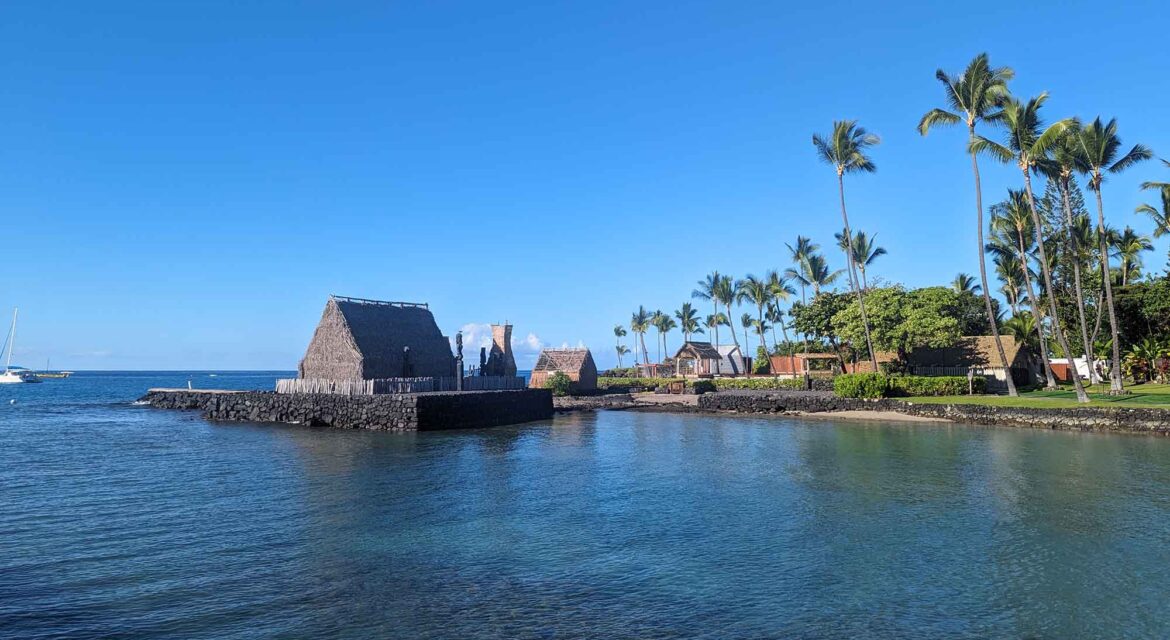 A reconstruction of an especially important structure in Hawaiian culture provides audiences with a sense of the incredible history that resides in Kailua-Kona on the island of Hawaiʻi (aka the Big Island). Ahu’ena Heiau is connected to an incredibly important era of the Kingdom of Hawaii but is now part of King Kamehameha’s Kona Beach Hotel, providing audiences with a sense of the past and present of Hawaii.
A reconstruction of an especially important structure in Hawaiian culture provides audiences with a sense of the incredible history that resides in Kailua-Kona on the island of Hawaiʻi (aka the Big Island). Ahu’ena Heiau is connected to an incredibly important era of the Kingdom of Hawaii but is now part of King Kamehameha’s Kona Beach Hotel, providing audiences with a sense of the past and present of Hawaii.

The Most Sacred Temple
 The word “heiau” in the Hawaiian language translates as a “temple” or place of worship, while Ahu’ena Heiau is translated as the “temple of the burning altar.” It was utilized by the community as an area of worship before 1812, but that was the year that Kamehameha I took up residence in the space and restored it. It became the center of political power at the time when the whole Hawaiian archipelago became unified as the Hawaiian Kingdom. The site was residential compound and served as the personal temple of Kamehameha, which he maintained until his death at the site in 1819.
The word “heiau” in the Hawaiian language translates as a “temple” or place of worship, while Ahu’ena Heiau is translated as the “temple of the burning altar.” It was utilized by the community as an area of worship before 1812, but that was the year that Kamehameha I took up residence in the space and restored it. It became the center of political power at the time when the whole Hawaiian archipelago became unified as the Hawaiian Kingdom. The site was residential compound and served as the personal temple of Kamehameha, which he maintained until his death at the site in 1819.
His passing directly preceded the next important happening at the location, which was the breaking of the ancient kapu system that defined the government administration. In 1820, the first missionaries to Hawaii arrived to the island at the location. This last development is why the location has been referred to as the “Plymouth Rock of Hawaii”
Over the decades, spirituality declined and the government moved elsewhere, causing Ahu’ena Heiau to lose its cultural significance. It would eventually be displaced by modern developments in Kona. In the 1970s, an effort to restore the site was begun. These efforts resulted in the recreation of Ahu’ena Heiau as it was once sketched by Louis Choris in 1816. These restored structures include the Hale Mana, the thatch-roofed prayer house, the House of Drums, and the oracle tower. Part of King Kamehameha’s Kona Beach Hotel, the structure is still so revered that no one is allowed to step foot inside or on the grounds surrounding it.
This direct connection to the modern setting has opened up opportunities related to events and gatherings, highlighting the incredible economic and cultural impact that the restoration of a piece of history can represent.

Among the Most Historic Locations in Hawaii
 Mentioned as one of the most historical sites in all of Hawaii, the nearby beach and hotel have ensured it is part of the present while also establishing a meaningful connection to the past. On the register of National Historic Landmarks, Ahu’ena Heiau is one of the lost powerful symbols of an appreciation of Hawaiian history that spans cultures and eras.
Mentioned as one of the most historical sites in all of Hawaii, the nearby beach and hotel have ensured it is part of the present while also establishing a meaningful connection to the past. On the register of National Historic Landmarks, Ahu’ena Heiau is one of the lost powerful symbols of an appreciation of Hawaiian history that spans cultures and eras.

